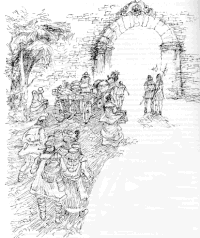Meet the Middle Ages
BackGoods from the country

The town people usually kept animals and owned a piece of land to farm. On the outskirts of the town, there were so-called cabbage gardens, where different kinds of vegetables were grown. The town owned pastures where the sheep and cows grazed. In this way, craftsmen and merchants were able to produce much of their own food. They could never be totally self-sufficient, though. They also had to buy produce from the peasants.
At market days the peasants came to town with carts loaded with the products of the season: grain, flour, eggs, meat, fruit and vegetables. Peasants from the coast brought fish. Those who lived in the woods in the interior, brought meat from the wild animals they had killed. All townspeople needed firewood to warm up their houses and to cook their food. The trade was lively at all the market squares in town. The craftsmen bought a lot of their raw materials from the peasants. Comb makers bought bone and horn, bakers bought flour, smiths bought iron and coal, the "remslagare" (belt makers) bought leather and the "buntmakare" (furriers) bought furs.
The merchants needed goods from the peasants as well, merchandise they could sell on to other places and make money; iron, fur, butter and dried fish.